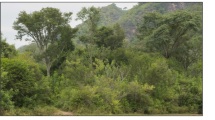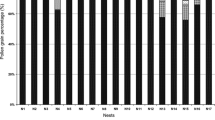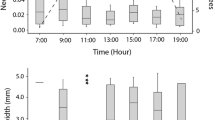Summary
The genus Capparis is represented in Israel by three taxons of the section spinosa. The pollinators of the three taxa are hawkmoths, crepuscular bees of the genus Proxylocopa and various daily bees. However, the efficiency of the different pollinators is very varied with respect to the individual taxons. Hawkmoths were frequently observed as pollinators of C. spinosa var. aravensis and C. ovata, but rarely on C. spinosa var. aegyptia. All the other bees, on the other hand, were found abundantly on all three taxons, all over the country. The three taxa all provide different rewards for their particular pollinators. Bees visiting C. spinosa var. aegyptia are provided with a lot of pollen but a relatively small amount of nectar, with a low sugar content. C. spinosa var. aravensis and C. ovata (the flowers visited more by hawkmoths), have less pollen but a higher amount of nectar which has a higher concentration of sugar. In drier habitats the emphasis of the reward provided by the flowers is nectar, whilst in the Mediterranean habitats it is the pollen which is the reward, without any connection to the systematic origin of the plant.
Similar content being viewed by others
References
Baker HG, Baker I (1973) Some anthecological aspects of the evolution of nectar-producing flowers, particularly amino-acids productionin nectar. In: Taxonomy and Ecology Heywood VH (ed) Academic press, London
Baker HG, Baker I (1975) Studies of nectar-constitution and pollinator-plant coevolution. In: Coevolution of Animals and Plants Gillbert LE, Raven PH University of Texas Press, Austin, pp 100–140
Bolten AB, Feinsinger P, Baker HG, Baker I (1979) On the calculation of sugar concentration in flower nectar. Oecologia (Berlin) 41:301–304
Brantjes NBM, Linskens HF (1973) Pollination and dispersal. Dept. of Botany, University of Njimegen.
Crane E (1975) Honey, Heinmann, London
Faegri K, Pijl L van der (1979) The Principles of Pollination Ecology. 3rd edit. Pergamon Press, Oxford
Gottsberger G, Schrauwen J, Linskens HF (1984) Amino acids and sugars in nectar, and their putative evolutionary significance. Pl Syst Evol 145:55–77
Grant V, Grant KA (1965) Flower pollination in the Phlox family. Columbia Univ. Press, New York
Inouye DW, Favre WD, Lanum JA, Levine DM, Meyers JB, Roberts MS, Tsao FC, Wang YJ (1980) The effect of nonsugar nectar constituents on estimates of nectar energy content. Ecology 61:992–995
Ivri Y (1985) Pollination and hybridization of Capparis spinosa and Capparis ovata (Capparaceae) in Israel. M.Sc. Thesis, University of Tel Aviv (in Hebrew)
Jacobs M (1965) The genus Capparis (Capparaceae) from the Indus to the Pacific. Blumea 12:385–541
Michener CD (1979) Biogeography of the bees. Ann M Bot Gard 66:277–347
Opler DA (1983) Nectar Production in the Tropical System. In: Bently B, Elias T (eds) The Biology of Nectaries. Columbia Univ. Press, New York
Proctor M, Yeo P (1973) The Pollination of Flowers, Collins, London
Willmer P (1983) Thermal constraints on activity pattern in nectar feeding insects. Ecol Ent 8:455–469
Zohary M (1960) The species of Capparis in the Mediterranean and the near eastern countries. Bul Res Coun Israel D8:49–64
Zohary M (1966) Flora Palestina. Vol. I. The Israel Academy of Sciences and Humanities, Jerusalem
Author information
Authors and Affiliations
Rights and permissions
About this article
Cite this article
Eisikowitch, D., Ivri, Y. & Dafni, A. Reward partitioning in Capparis spp. along ecological gradient. Oecologia 71, 47–50 (1986). https://doi.org/10.1007/BF00377319
Received:
Issue Date:
DOI: https://doi.org/10.1007/BF00377319




